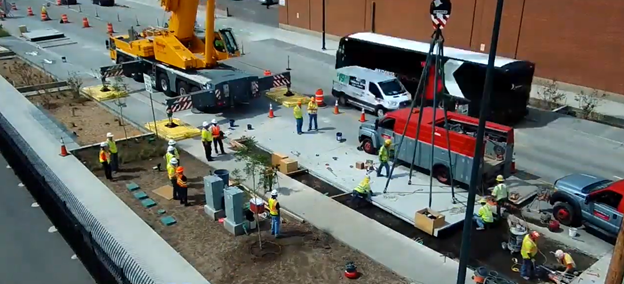Smart Pavement is a technology capable of providing simple, compact deployment of various smart systems along roadways. The technology is typically made up of precast concrete slabs intended to replace and outlast more traditional asphalt. Modular systems embedded inside have the capacity to receive software upgrades and an expansion port (described as the size of a soda can) that allows a new technology to be integrated.
Project Purpose
The slabs currently produced allow for wireless EV charging; use of in-road sensors and antennae systems to locate vehicles in two distinct ways, improving accuracy and reliability while eliminating the latency inherent when relying on distant satellites for A-PNT; and sensors of sufficient sensitivity to provide anonymous real-time traffic data on speeds, lane usage, make, model, year, weight, and more of each passing vehicle.[i] A-PNT is a global navigation satellite system (GNSS) adjacent to GPS. PNT can be labeled as Assured when their signals are technologically safeguarded from both natural and human-caused disruptions. Latency or delay is inherent given distance.[ii]
Beyond providing data on pavement conditions to allow timely repair or enabling immediate accident response, these sensors have considerable utility for research on the impact on traffic conditions of local events, changing weather conditions, and more. Ongoing testing in Denver, Colorado has attracted interest from academics hoping to make use of collected data, while a demonstration for the Kansas DOT (KDOT) has emphasized potential cost-saving benefits. Rather than fronting the complete cost of “at the edge ITS integration” for one component or desired benefit, the technology’s creators speak of a model where distinct benefits for the public and private sectors from different components or data could see partnerships to invest in the system. For DOTs and transportation agencies, embedded sensors could allow efficient and cost-effective remote access to data used in ITS, avoiding the need to work from a transportation management center.[iii]
Outcomes
In 2017, the Colorado DOT (CDOT) contracted the deployment of a segment of Smart Pavement on Route 285, a rural stretch from the New Mexican border through the San Luis Valley to Denver, as well as a demonstration site within Denver, seen in Figure 23. This contract was ended in 2019 due to changing priorities, with subsequent testing and deployment based on a private financing model with little to no government funding.[iv] Without local, state, or federal government funding to facilitate more widespread deployment, early usage of Smart Pavement and similar technologies may be concentrated in urban areas.[v]

A screenshot of the installation of Smart Pavement on Brighton Boulevard at 39th St in Denver, Colorado, completed in collaboration with CDOT’s RoadX program, the City and County of Denver, and other public and private sector partners. Source: Integrated Roadways, 2019
Traffic and population density make this a matter of economics for many such technologies. Given time, growth, and increased production capacity, expansion into rural areas will grow more cost effective, with or without government involvement. There are benefits of such technologies to rural communities which may warrant investigation or public-private partnership to accelerate that process.[vi]
Beyond providing broadband access which could better facilitate remote work in low cost-of-living areas, Smart Pavement’s creators cited a potential use for the rural bridges that often serve as chokepoints for agricultural traffic. In edge cases where a trailer nears or exceeds a weight limit, a bridge instrumented to give reports on its own condition could allow companies to efficiently determine if an additional trailer or alternate route is warranted or enable an overweight fee to be assessed based on the weight of the load and the bridge’s condition. This integration would bring both passive efficient improvements to nationwide logistics and avoid a potential infrastructure failure with all the safety and economic consequences that brings. Redeveloping the existing information tech systems to facilitate this service and serve rural regions is within producers’ existing technological capacity, but it would again require government or private funding to facilitate development and deployment until a clear market justifies a for-profit entity taking such action.[vii]
Resources
Modular production and installation of smart pavement slabs assists with managing the costs involved in deploying and maintaining the infrastructure. Smart Pavement slabs (which are horizontal, whereas panels are vertical) are designed for quick engineering and fabrication, with a standardized design capable of being customed to local specifications. Installation is described as simple, with the slabs raised or lowered to a needed height by an internal leveling system. Maintenance of these slabs is largely identical to that of standard concrete pavement, with the largest warning being to treat each unit as such and avoid dismantling or sawing through them. While the vendor presently operates all the systems it delivers, this is not a necessity beyond the limited knowledge about their utilization. In the future, an easy-use software package would enable clients to manage and replace slabs, or similar compact ITS deployments, fully self-sufficiently.[viii]
[i] Personal communication with Tim Sylvester, January 2023
[ii] Oscilloquartz. (nd). “What is assured PNT?” https://www.oscilloquartz.com/en/products-and-services/technology/what-is-assured-pnt
[iii] Personal communication with Tim Sylvester, January 2023
[iv] Personal communication with Tim Sylvester, January 2023
[v] Personal communication with Tim Sylvester, January 2023
[vi] Personal communication with Tim Sylvester, January 2023
[vii] Personal communication with Tim Sylvester, January 2023
[viii] “What is assured PNT?” Oscilloquartz. https://www.oscilloquartz.com/en/products-and-services/technology/what-is-assured-pnt
This report was delivered to the U.S. Department of Transportation in 2023. It was primarily authored by NADO Associate Director Carrie Kissel and NADO Research Fellow Danny Tomares. Many transportation agency staff and others assisted with this project in a variety of ways. We offer deep and heartfelt thanks to all the individuals who have provided information and images, consented to be interviewed, and offered editorial guidance in support of this research. Any opinions, findings and conclusions, or recommendations expressed in this publication are those of the authors and do not necessarily reflect the views of U.S. DOT or the NADO Research Foundation.
To read more about the NADO Research Foundation’s ITS case studies, follow this link.


